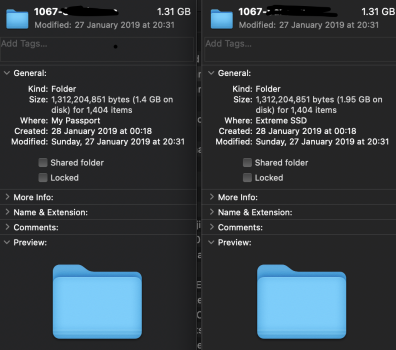Hi Everyone.
Apologies if this is the posted in the wrong place.
I have a 2TB Western Digital My passport HDD and have copied all files to a 2TB SanDisk Extreme SSD.
From Terminal, the WD drive details are as follows:
Device Identifier: disk4s1
Device Node: /dev/disk4s1
Whole: No
Part of Whole: disk4
Volume Name: My Passport
Mounted: Yes
Mount Point: /Volumes/My Passport
Partition Type: Windows_NTFS
File System Personality: ExFAT
Type (Bundle): exfat
Name (User Visible): ExFAT
OS Can Be Installed: No
Media Type: Generic
Protocol: USB
SMART Status: Not Supported
Volume UUID: 6BEC41AC-3CBE-3154-B062-EE077608F971
Partition Offset: 1048576 Bytes (2048 512-Byte-Device-Blocks)
Disk Size: 2.0 TB (2000364240896 Bytes) (exactly 3906961408 512-Byte-Units)
Device Block Size: 512 Bytes
Volume Total Space: 2.0 TB (2000301326336 Bytes) (exactly 3906838528 512-Byte-Units)
Volume Used Space: 1.2 TB (1171128320000 Bytes) (exactly 2287360000 512-Byte-Units) (58.5%)
Volume Free Space: 829.2 GB (829173006336 Bytes) (exactly 1619478528 512-Byte-Units) (41.5%)
Allocation Block Size: 131072 Bytes
Media OS Use Only: No
Media Read-Only: No
Volume Read-Only: No
Device Location: External
Removable Media: Fixed
Solid State: Info not available
And the SSD details are as follows:
Device Identifier: disk5s1
Device Node: /dev/disk5s1
Whole: No
Part of Whole: disk5
Volume Name: Extreme SSD
Mounted: Yes
Mount Point: /Volumes/Extreme SSD
Partition Type: Microsoft Basic Data
File System Personality: ExFAT
Type (Bundle): exfat
Name (User Visible): ExFAT
OS Can Be Installed: No
Media Type: Generic
Protocol: USB
SMART Status: Not Supported
Volume UUID: 4CE2FDB8-F540-3195-91AF-463C458FF4E9
Disk / Partition UUID: A36307F2-9978-46D0-BF5A-D6EA849A01DF
Partition Offset: 1048576 Bytes (2048 512-Byte-Device-Blocks)
Disk Size: 2.0 TB (2000363274752 Bytes) (exactly 3906959521 512-Byte-Units)
Device Block Size: 512 Bytes
Volume Total Space: 2.0 TB (2000353755136 Bytes) (exactly 3906940928 512-Byte-Units)
Volume Used Space: 1.2 TB (1213107011584 Bytes) (exactly 2369349632 512-Byte-Units) (60.6%)
Volume Free Space: 787.2 GB (787246743552 Bytes) (exactly 1537591296 512-Byte-Units) (39.4%)
Allocation Block Size: 1048576 Bytes
Media OS Use Only: No
Media Read-Only: No
Volume Read-Only: No
Device Location: External
Removable Media: Fixed
Solid State: Info not available
I would like to understand why the SSD is using 40 GB more space for the same files? Also attached is a screen grab of the same folder on both drives showing the different sizes on disk (1.4GB vs 1.95GB).
Your help is appreciated.
Apologies if this is the posted in the wrong place.
I have a 2TB Western Digital My passport HDD and have copied all files to a 2TB SanDisk Extreme SSD.
From Terminal, the WD drive details are as follows:
Device Identifier: disk4s1
Device Node: /dev/disk4s1
Whole: No
Part of Whole: disk4
Volume Name: My Passport
Mounted: Yes
Mount Point: /Volumes/My Passport
Partition Type: Windows_NTFS
File System Personality: ExFAT
Type (Bundle): exfat
Name (User Visible): ExFAT
OS Can Be Installed: No
Media Type: Generic
Protocol: USB
SMART Status: Not Supported
Volume UUID: 6BEC41AC-3CBE-3154-B062-EE077608F971
Partition Offset: 1048576 Bytes (2048 512-Byte-Device-Blocks)
Disk Size: 2.0 TB (2000364240896 Bytes) (exactly 3906961408 512-Byte-Units)
Device Block Size: 512 Bytes
Volume Total Space: 2.0 TB (2000301326336 Bytes) (exactly 3906838528 512-Byte-Units)
Volume Used Space: 1.2 TB (1171128320000 Bytes) (exactly 2287360000 512-Byte-Units) (58.5%)
Volume Free Space: 829.2 GB (829173006336 Bytes) (exactly 1619478528 512-Byte-Units) (41.5%)
Allocation Block Size: 131072 Bytes
Media OS Use Only: No
Media Read-Only: No
Volume Read-Only: No
Device Location: External
Removable Media: Fixed
Solid State: Info not available
And the SSD details are as follows:
Device Identifier: disk5s1
Device Node: /dev/disk5s1
Whole: No
Part of Whole: disk5
Volume Name: Extreme SSD
Mounted: Yes
Mount Point: /Volumes/Extreme SSD
Partition Type: Microsoft Basic Data
File System Personality: ExFAT
Type (Bundle): exfat
Name (User Visible): ExFAT
OS Can Be Installed: No
Media Type: Generic
Protocol: USB
SMART Status: Not Supported
Volume UUID: 4CE2FDB8-F540-3195-91AF-463C458FF4E9
Disk / Partition UUID: A36307F2-9978-46D0-BF5A-D6EA849A01DF
Partition Offset: 1048576 Bytes (2048 512-Byte-Device-Blocks)
Disk Size: 2.0 TB (2000363274752 Bytes) (exactly 3906959521 512-Byte-Units)
Device Block Size: 512 Bytes
Volume Total Space: 2.0 TB (2000353755136 Bytes) (exactly 3906940928 512-Byte-Units)
Volume Used Space: 1.2 TB (1213107011584 Bytes) (exactly 2369349632 512-Byte-Units) (60.6%)
Volume Free Space: 787.2 GB (787246743552 Bytes) (exactly 1537591296 512-Byte-Units) (39.4%)
Allocation Block Size: 1048576 Bytes
Media OS Use Only: No
Media Read-Only: No
Volume Read-Only: No
Device Location: External
Removable Media: Fixed
Solid State: Info not available
I would like to understand why the SSD is using 40 GB more space for the same files? Also attached is a screen grab of the same folder on both drives showing the different sizes on disk (1.4GB vs 1.95GB).
Your help is appreciated.
Attachments
Last edited:


